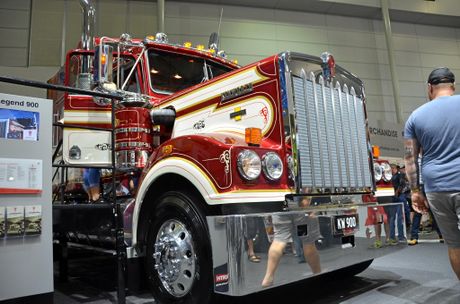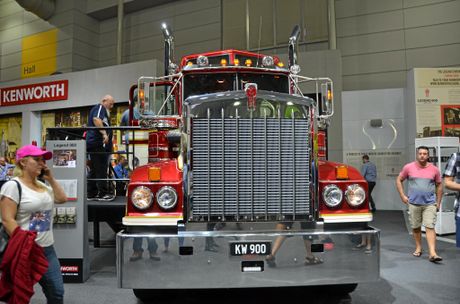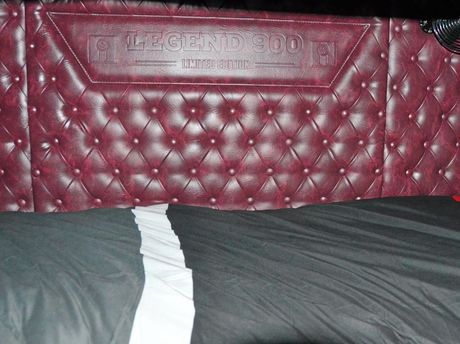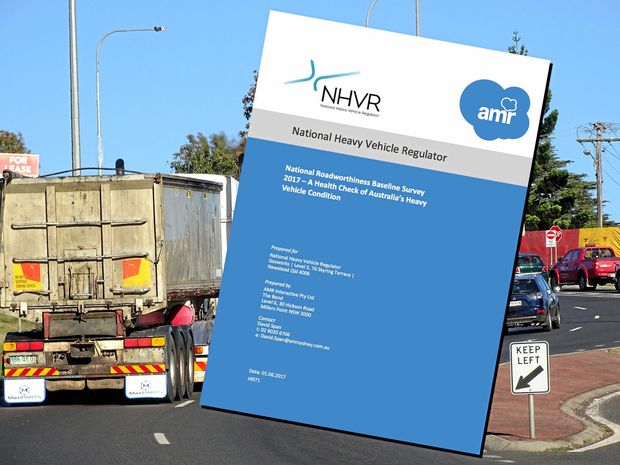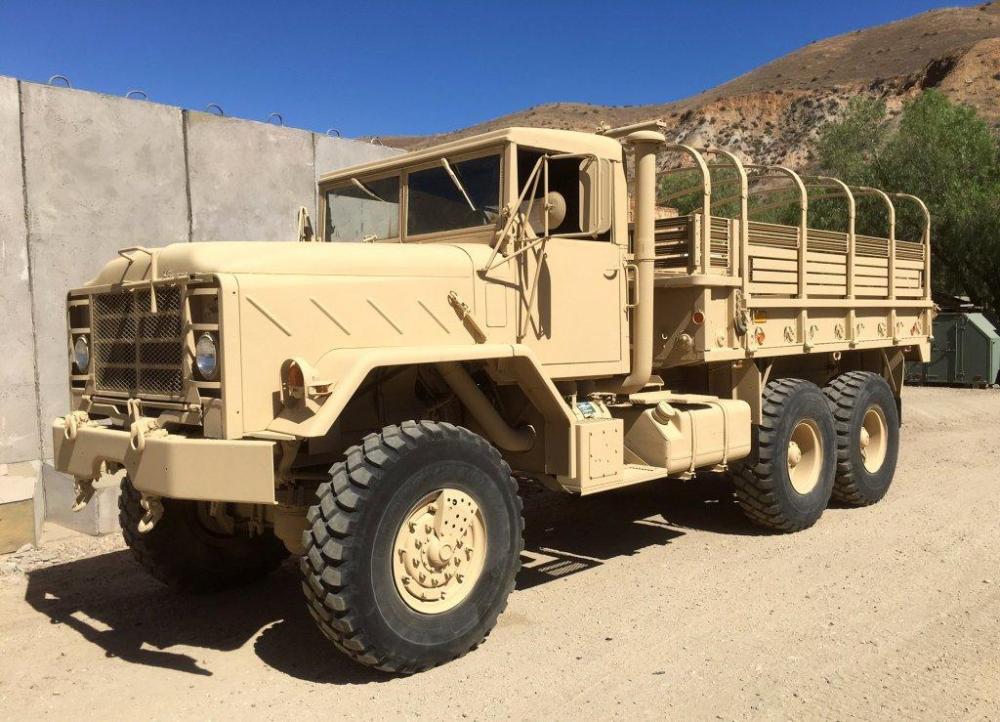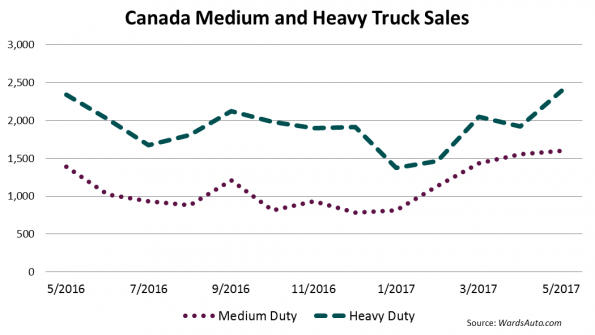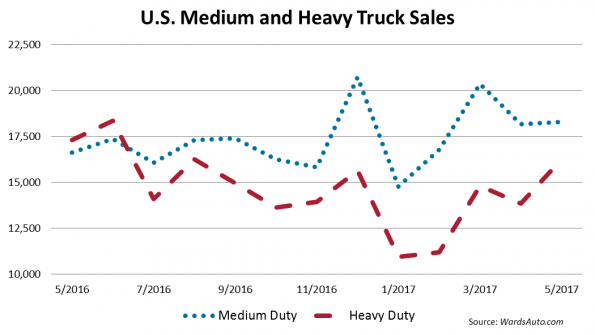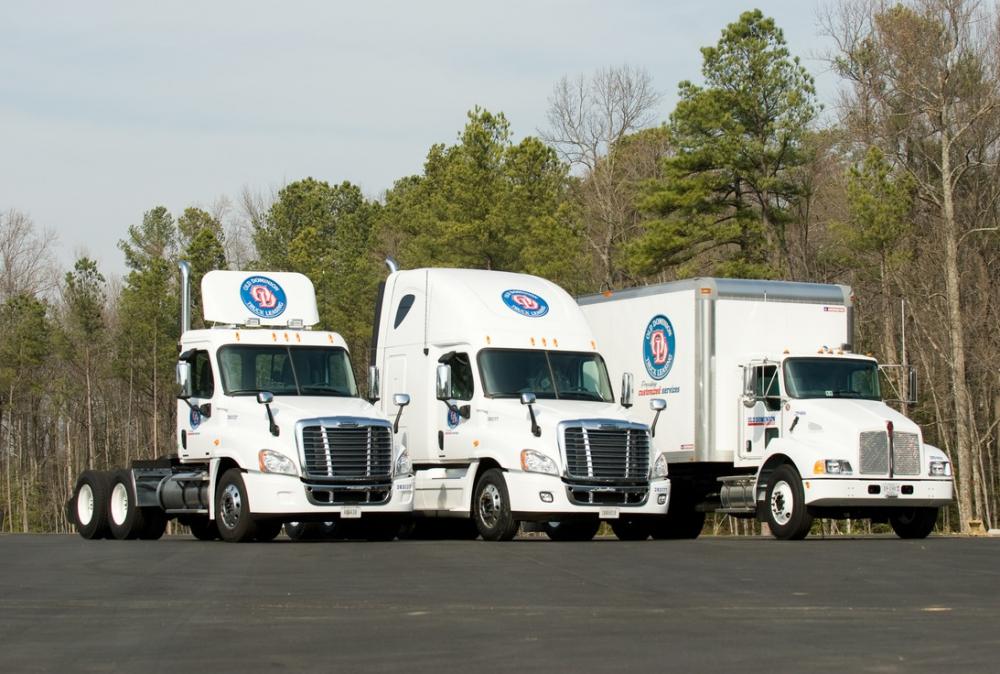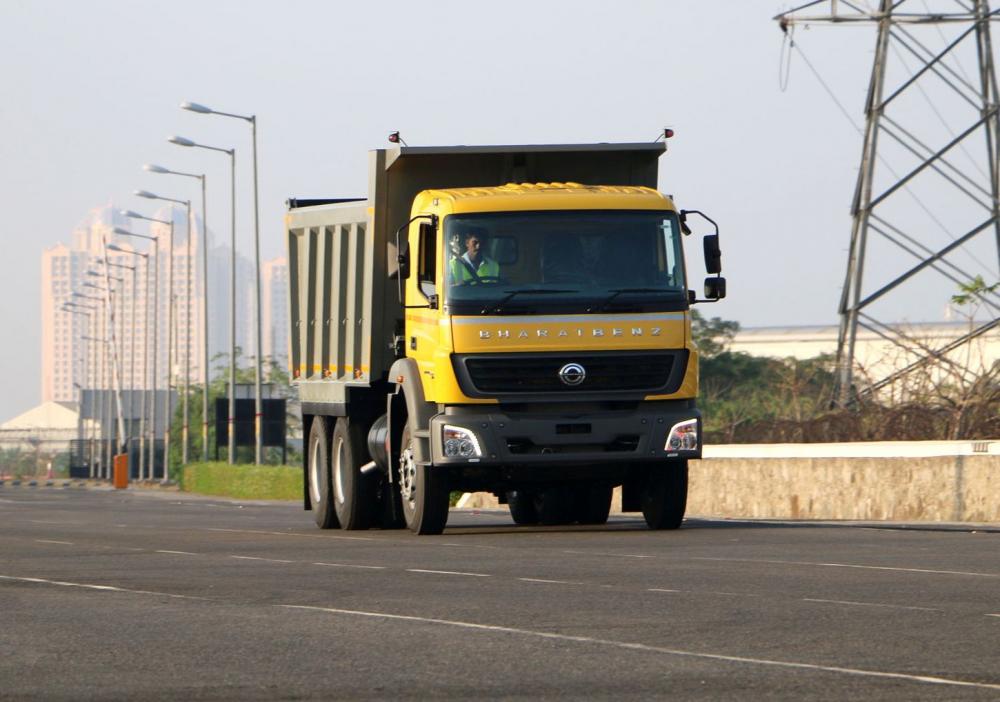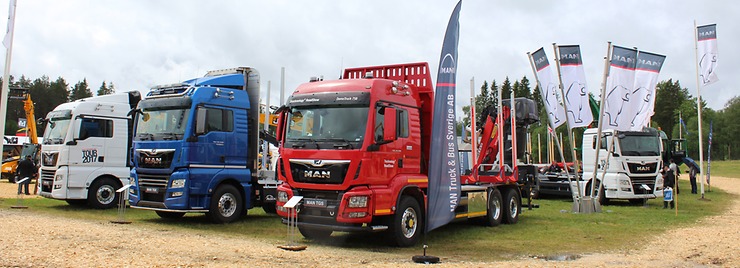
kscarbel2
Moderator-
Posts
18,885 -
Joined
-
Days Won
114
Content Type
Profiles
Forums
Gallery
Events
Blogs
BMT Wiki
Collections
Store
Everything posted by kscarbel2
-
Cummins to put fully electrified powertrain system on road in 2019
kscarbel2 replied to kscarbel2's topic in Trucking News
Cummins Makes Big Electrification Move Heavy Duty Trucking / June 15, 2017 Cummins announced that it will have a fully developed, all-electric powertrain available and on the road for customers in 2019, with a range-extended electric vehicle coming in 2020. The company made the announcement during a conference call Wednesday evening. Tom Linebarger, Cummins chairman and CEO, noted in opening remarks that the transportation industry is at “critical juncture” today. “We understand that electrification is coming and that the world is changing,” Linebarger said. “Regulations and a technological point of view are driving these changes, and we think that means opportunity. Cummins is a power technology company. We will continue to innovate with new technology and look for ways to disrupt ourselves, instead of having our competitors disrupt us. We will bring the right technology to markets – not just trucking -- that will help our customers win while being a leader provider of those products in the future.” Julie Furber, executive director of Cummins’ electrification business, said the company will leverage its knowledge and capability to offer entirely new powertrain solutions in the future for commercial and industrial markets. This initiative will begin next year with the introduction of a fully electric transit powertrain, closely followed by an extended-range electric vehicle in 2020. In an email to investors, financial advisory firm Stifel noted, "To us, that’s a big deal as it demonstrates the company is further along than was previously known in addressing what is likely its single biggest long-term risk: that electric will replace diesel as the dominant fuel source for commercial vehicle powertrains." “At Cummins, we think we know things about electrification our competitors do not,” Furber said. “In the short term, we believe electrification will come to transit bus, P&D and material handling segments. In the long term, this technology will come to all of the markets we serve in one form or another. "Environmental and noise reduction regulations along with social pressure for environmental sustainability will drive adoption. As a leading provider of this technology, Cummins must make sure the cost and performance perspectives of this technology is viable so the long-term economics are in place for favorable cost of ownership later on, as trucks, off-highway and mining equipment as well as stationary power segments turn to electrification.” -
Cummins to put fully electrified powertrain system on road in 2019
kscarbel2 replied to kscarbel2's topic in Trucking News
Cummins plans electrified powertrain system in 2019 Fleet Owner / June 15, 2017 City buses will likely be the first vehicles equipped with this new technology, the OEM’s executives said. During a conference call this week with reporters, engine maker Cummins’ executive director of electrification business development Julie Furber said that the OEM plans to have a fully electrified powertrain system on the road by the end of 2019. She said that transit buses in cities globally would likely be the first vehicles to have the new technology. Other top executives said other industrial and commercial uses would follow. “We know things about electrification that maybe others don’t,” she explained during the hour-long session with reporters. “We believe that electrified power will come to all of our markets in one way, shape or form.” Cummins chairman and CEO Tom Linebarger said on the call that the company was upping its investment into electrification while continuing to focus on diesel fuel engines as well. He stressed that Cummins was more than an engine maker, now and going forward. “We are also a technology company,” he asserted, while also stressing that “the trucking industry was built on the back of Cummins. But we are not just a diesel engine company. Oftentimes because we’ve been so successful in diesel engines people think that’s what defines Cummins, and it isn’t. We are a power technology company.” Michael Baudendistel, vice president of the Stifel Transportation & Logistics Research Group – a division of Stifel Capital Markets – added in a research brief that the Cummins powertrain announcement is a “big deal” as it demonstrates the company is further along than was previously known in addressing what is likely its single biggest long-term risk: that electric will replace diesel as the dominant fuel source for commercial vehicle powertrains. “We believe there are still many unanswered questions” about electric commercial vehicles, he noted, the “big three” being cost, weight, and range. For that reason “the pace of adoption [of electric powertrains] will be slower than seen in light vehicles,” Baudendistel said. “But, no matter the timeline or eventuality, we believe Cummins has demonstrated that it intends to be a major player in that market when it develops and that it will not be caught flat-footed if the market moves away from its core diesel engine business,” he pointed out. “We believe the reality is closer to how Tom Linebarger [Cummins CEO and chairman] described,” Baudendistel emphasized. “Essentially, the company is a power generation technology company that is investing an a wide range of alternative fuels in order to disrupt its industry leading diesel engines before the company can be disrupted by a competitor.” He also highlighted Cummins’ plans to increase research and development investment above its historical 3% to 4% range in order to fund investment in electrification and other “digital” offerings, such as telematics. “In our view, money well spent,” Baudendistel said. -
Gold mack
kscarbel2 replied to ranchhopper's topic in Antique and Classic Mack Trucks General Discussion
The thing is, it feels as though that event was just yesterday. The entire company, including the factory branches and dealers, was excited because we knew that we about to redefine the industry. The original cool power 300s would run circles around today's 400s. That whistle meant massive torque at your disposal. -
Last Friday, Trump said Qatar was a country with "extremist ideology” that "has historically been a funder of terrorism at a very high level.” Five days later, this Wednesday, we're selling Qatar 36 F-15s for $12 billion (they have an option for 36 more......a total of 72). Makes sense......right?
-
-
Kenworth's legendary 900 Big Rigs / June 15, 2017 Despite the bright lights, innovations and virtual reality spectacles of the Brisbane Truck Show, no display was able to beat the undoubted vintage charm of the new Kenworth Legend 900. As one of the most lusted-after vehicles on the showroom floor, the nostalgic rig, modelled on the legendary W-model introduced in 1991, embraces classic features not often found in vehicles made today. In order to celebrate Kenworth's heritage, the 900 combines the iconic model with the original styling accents from the manufacturer's early years in Australia. Powered by a Cummins X15 engine, specially painted in red and black to commemorate the Cummins N14 engine that was fitted to many of the original T900s, the rig also boasts side-mounted exhausts with a wraparound cover, and exposed chrome elbows, and a traditional flat dash layout which houses a full suite of handmade heritage style chrome-bezeled and white-faced gauges. However punters wanting to own this limited edition model will have to get in quick, as the Legend will be on sale for - wait for it - just one day. Yes, the Legend will be on sale for one day only - June 26 this year. Kenworth general sales manager David Harmsworth said the 24-hour purchase window was to promote the limited nature of the sought-after model. "We wanted to allow those who want to purchase a Legend 900 to have their chance to own a piece of history," David said. As such, only a limited number of the Legend 900s will be manufactured, each built to specification and marked with their individual limited edition number. The American-style long-bonneted truck's grunt and old-world style has unsurprisingly gained a strong following since it was announced. "There has been a huge amount of excitement about the Legend 900 from the public, starting from well before the model was even publicly announced," David said. "We have had numerous requests for brochures from people outside our normal networks. "There are Facebook groups that have been set up for this specific model and anecdotally we have heard from people that the truck has created a huge buzz," David said. While the Legend 950 in 2015 was a clear launching point for the limited edition historic Kenworth model, the 900's planning process didn't begin until more recently. "There was always a plan to create another Legend model," David said, hinting at what is to come. "It is likely the Legend Series will continue in the future, though no models have yet been selected nor dates set." .
-
B-doubles and road trains are continually demonised by Australia’s mainstream press and television current affairs programs. Well suck it up you purveyors of misinformation, the results of a recent nationwide in-depth survey are in showing linehaul operations, running predominantly B-double and road train combinations are the safest in Australia. The National Heavy Vehicle Regulator coordinated a National Roadworthiness Baseline Survey (NRBS) of 7130 heavy vehicles across Australia. The inspections took place from August to November in 2016 and since then an independent statistics organisation has been crunching the numbers and has produced some surprising results. Throughout the survey, 364 transport inspectors inspected rigid trucks, semi-trailers, B-doubles, road trains, buses and special purpose vehicles at 168 inspection sites. These inspections took place at roadside checkpoints, state inspection facilities and in transport operator depots. Detractors of the road transport industry have used ABS statistics showing that the average truck age in Australia as being 14 years old, a figure referenced to show an ageing and dangerous fleet on Australian roads. This new study shows that these figures are false, based on registrations rather than trucks actually using the country's highways. Registrations cover many trucks parked on farms, stations and small communities under special registration protocols that do not require annual inspections and often rarely spend any time on main roads and highways. The NHVR study took random samples from trucks actually using the highways and the survey has produced a far more grounded snapshot of the trucks on Australian roads. The average age of on-road trucks of all types is now seen to be nine years, significantly under the ABS figures. Rigid trucks fare the worst in the inspections with an average age of 9.9 years old. Semi-trailers used in a wide variety of purposes, short, medium and long haul, have an average age of 8.7 years. And it is here the big shift in perspective comes about, with B-doubles having an average age of 5.2 years and road trains 5.4 years, an average age that gives the types of trucks used mostly on linehaul the youngest age, and from inspections and defect notices notices, the safest trucks on the road. In a media statement, the NHVR said the NRBS data demonstrates that the in-service linehaul fleet is on average five years younger than the average age. For the survey, main roads inspectors of the various jurisdictions were trained in inspection protocols to set a consistent standard over the period of the survey so that the data was solid. All Australian states and territories took place in the study with the exception of Western Australia who, according to the NHVR, was not against the study but didn't get its ducks in a row in time, and is involved in ongoing analysis. This first round of statistical analysis has given a baseline snapshot of the state of the national fleet upon which ongoing studies can use to make comparisons of improvements or otherwise over the years. During the survey the 7130 vehicle combinations were inspected, made up of 11,066 vehicle units including hauling units and trailers. 3227 rigid trucks were inspected 1221 semitrailers 802 B-double sets 221 road trains 1015 buses and coaches 644 cranes and special purpose vehicles. Of the 11,066 vehicle units inspected, only 147 were grounded. Major non-conformities are classified when a critical concern over the safety of a vehicle is found forcing the truck to be grounded. "The Australian heavy vehicle fleet is well-maintained and generally operating in a safe condition," the regulator said. This means 1.3% of vehicle units were grounded through the course of the study, including 82 hauling units and 64 trailers. Authorised officers conducting #NHVR #roadworthiness survey found 1.3% couldn't continue trip – 98.7% safe to travel https://t.co/ybcXEff6Bg pic.twitter.com/9bOfN5zsNB — NHVR (@NHVR) June 2, 2017 Looking at the breakdown, non-conformity was found the highest in rigid trucks and their accompanying trailers. Semi-trailers too fared badly in nonconformity, rigid trucks at 13%, semi-trailers at 14%. Better results of 8% of B-doubles and 10% of road trains were found to be nonconforming. Top of the class goes to buses and coaches with only 2% nonconformity. Examples of major nonconformities include when a vehicle falls short of the brake performance required when tested on a roller brake tester. #NHVR #roadworthiness - brakes, steering/suspension lights/reflectors, engines most likely for non-conformities https://t.co/ybcXEff6Bg pic.twitter.com/gyGphzueYs — NHVR (@NHVR) June 2, 2017 Taking a global perspective, the 1.3% of grounded nonconformities in Australia compares to 21.5% in a similar inspection survey in the United States. The National Roadworthiness Baseline Survey set out to create the most consistent, focused and efficient inspection approach ever done in this country. The data enables the regulator to identify high-risk vehicle components, vehicle systems, vehicle types, operators and industry sectors. The knowledge gained in the survey could lead to focused sector inspection targets where a particular type of truck or a particular vocation is targeted where maintenance issues and nonconformity have been identified. The data released in June is the first result gained from more than two million pieces of data collected during the inspection. "We wanted to understand the rate of major nonconformity. Where authorised officers found major nonconformities the majority were assessed as safe enough to continue their journey but required repair within a specified period of time," NHVR CEO Sal Petroccitto said. "The rate of major nonconformities in the Australian fleet compared well to the UK which had a 35% major nonconformity rate and to the US for about one fifth the vehicles inspected are grounded." A strange twist The first results of the NRBS were released on Friday June 2. The next working day, the following Monday, the Heavy Vehicle Industry Australia (previously the Qld-based CVIAQ) sent out a release "HVIA puts brakes on NHVR's survey results". HVIA appeared to whinge the brake testing methodology, adding confusion, another case of the industry shooting it's self in the rhetoric foot. .
- 1 reply
-
- 1
-

-
New fuel-efficient axle available for Mercedes-Benz Actros from July 2017 Active oil management in the final drive reduces fuel consumption by 0.5 percent and is without parallel worldwide New ultra-modern assembly line inaugurated in Kassel Dr Frank Reintjes: "The second generation of the Integrated Powertrainfrom Daimler Trucks – consisting of engine, transmission and axle – has already reduced fuel consumption of the Mercedes-Benz Actros by up to 6 percent and guarantees the lowest possible Total Cost of Ownership. The world's first intelligent truck axle enables us to reduce fuel consumption by a further 0.5 percent. This demonstrates once again our technology leadership and directly pays off for our customers." Kassel – Production of the new fuel-efficient truck axle started yesterday at the Mercedes‑Benz plant in Kassel. The rear axle reduces fuel consumption of the Mercedes-Benz Actros by up to 0.5 percent. In addition to the weight savings, the New Final Drive (NFD) particularly benefits from the actively controlled oil regulation in the final drive, the heart of the axle. This technology and type of construction is without parallel worldwide: the lubricating oil is supplied as needed depending on the speed, torque and temperature. Intelligent oil management minimises the swirl of liquid in the final drive and thus reduces the friction loss from the gears turning in the oil bath. The New Final Drive axle completes the second generation of the Integrated Powertrain from Daimler Trucks and results in fuel savings of up to 6.5 percent for the Mercedes‑Benz Actros compared with its predecessor. As part of the Daimler Trucks platform strategy, the new truck axle will be produced at the Mercedes‑Benz plant in Kassel and also at the US site in Detroit. "The second generation of the Integrated Powertrain from Daimler Trucks – consisting of engine, transmission and axle – has already resulted in fuel savings of up to 6 percent for the Mercedes‑Benz Actros and ensures the lowest possible Total Cost of Ownership. The world's first intelligent truck axles even enable us to reduce fuel consumption by a further 0.5 percent. This once again demonstrates our technology leadership and directly pays off for our customers", says Dr Frank Reintjes, Head of Global Powertrain and Manufacturing Engineering Trucks. About the new rear axle assembly line in Kassel On 13 June 2017 the Mercedes‑Benz plant in Kassel had two reasons to celebrate: the start of series production of the fuel-efficient truck axle and the inauguration of the ultra-modern assembly line that was constructed at the site in recent months. The plant boasts cutting-edge production technologies and a high level of automation. For example, components inside the axle can now be directly welded together with new laser technology instead of being bolted. The resulting smooth mating surfaces reduce unnecessary oil swirl in the final drive and have a positive effect on fuel consumption. A total sum of around 30 million euros has been invested in the new NFD assembly line in Kassel. "The new truck axle with active oil regulation is the first axle of this type and offers our customers a clear competitive edge thanks to reduced fuel consumption. We also benefit from this at the Mercedes‑Benz plant in Kassel. Cutting-edge product technologies and extensive investments in production facilities ensure that the site will remain profitable and competitive in future", says Ludwig Pauss, site manager of the Mercedes‑Benz plant in Kassel. About the fuel-efficient Integrated Powertrain The Integrated powertrain from Daimler Trucks is perfectly coordinated and in addition to cost and efficiency advantages it also offers the lowest Total Cost of Ownership for transport companies. Fuel savings of up to six percent can be achieved for the Mercedes‑Benz Actros models. The enhanced OM 470 and OM 471 engines in conjunction with the optimised twelve-speed transmission and the improved Predictive Powertrain Control (PPC) shift strategy contribute to the low fuel consumption. About the Global Powertrain integrated production network Daimler Trucks Global Powertrain stands not only for the integrated drive system itself, but also for the integration of all global sites and relevant functions along the whole value chain. The powertrain plants in Germany (Mannheim, Gaggenau and Kassel), the USA (Detroit), Brazil (São Bernardo), India (Oragadam) and Japan (Kawasaki) produce innovative and reliable drive components with uniform global quality standards. The components are used in all Daimler commercial vehicle divisions and brands and by external customers. About the Mercedes-Benz plant in Kassel The Mercedes‑Benz plant in Kassel is Daimler's global centre of excellence for commercial vehicle axles. With around 3000 employees it is Europe's largest commercial vehicle axle plant and the largest industrial employer in Kassel. Cutting-edge production processes are used to produce axles for trucks, vans and cars and also propeller shafts and gear sets. .
-
Full speed ahead for self-driving trucks Scania Group Press Release / June 14, 2017 Scania is now introducing self-driving trucks and buses for trials on public roads. This follows the successful development of self-driving trucks for closed areas, such as mines, ports and terminals. “Driving in a straight line in a smooth manner at speeds approaching 90 kilometres an hour is more difficult than one would expect.” Scania is thereby taking autonomous transport solutions to a new higher level. “The development of transport automation is occurring much quicker than anyone could have imagined just a couple of years ago,” says Tom Nyström, Expert Engineer at Scania for Autonomous Transport Solutions. Platoons to reduce carbon dioxide emissions Driving in platoons to reduce air drag has long been recognised as an effective means of lowering fuel consumption, and thereby CO2 emissions. The European auto industry has outlined needed regulatory changes for the widespread introduction of semi-automated convoys by 2023. Meanwhile, others are taking initiatives to leapfrog development by introducing fully autonomous platoons well ahead of that date. Scania is cooperating with the Singapore Ministry of Transport and the Port of Singapore Authority (PSA Corporation) to design the world’s first full-scale autonomous truck platooning operations. The platoon will traffic public roads while transporting containers between port terminals in Singapore. In preparation for the Singapore operation, Scania recently deployed a fully autonomous platoon with three trucks travelling at the typical European speed of 80 km/h with a one-half second gap, equal to approximately ten metres. “We’re fine-tuning systems and building experience for coming complex environments such as public roads and especially cities.” Autonomous city buses in the making The time may not yet be ripe for autonomous buses in cities but that does not deter Scania from pushing the boundaries of coming technology. An autonomous city bus now plies a route at Scania’s R&D facilities in Södertälje. The downloaded timetable triggers the bus to depart autonomously, making planned intermediate stops for embarking and disembarking passengers. Most challenging of all will be urban distribution, according to Tom Nyström. “One of the real benefits will the opportunities for swift and rational night time deliveries when autonomous trucks can travel unimpeded by traffic congestion.” .
-
Scania Group Press Release / June 12, 2017 Europe’s truck manufacturers have presented a detailed timeline of steps leading up to the introduction of convoys of semi-automated trucks on Europe’s motorways before 2025. The EU Roadmap for Truck Platooning also provides guidance to policy makers and authorities on the regulatory changes and political support necessary for cross-border truck platooning. “The technology for platooning with trucks of the same brand is already available today. But clearly customers will need to be able to platoon with trucks of different brands, so our next objective is to introduce multi-brand platooning,” said Erik Jonnaert, Secretary General of the European Automobile Manufacturers’ Association (ACEA), when he presented the roadmap to the European Parliament. Autonomous trucks By 2023, it should be possible to drive across Europe on motorways with multi-brand platoons, without needing any specific exemptions for crossing national borders – a prerequisite for international transport. Subsequently, allowing the driver of a trailing truck to rest might come under consideration. However, full autonomous trucks will only come later, according to Jonnaert. While Scania and other manufacturers are already exploring the business case for truck platooning with the logistics sector, certain conditions that need to be met before 2023 are beyond the control of the truck industry. “That’s why we will also need to strengthen cooperation between all players involved, including operators of road infrastructure, transport companies, regulators and insurance companies, but policy makers in particular.” Europe will need to create a supportive regulatory framework before truck platooning can become a common sight. “And that’s exactly where the policy makers come in. They will need to develop new rules, make changes to existing legislation, and harmonise international and EU rules,” said ACEA’s Erik Jonnaert.
-
If you mean sell Afghanistan 115 used M923A2's, I'm all for it. So long as the US taxpayer isn't paying for it. .
-
Wards Auto / June 14, 2017 The Canadian big-truck industry had a good month in May, up 2.7% from year-ago with small drops in Classes 6 and 8. With one more selling day this year than last, truck makers sold 3,996 units compared to 3,734 in like-2016. Class 8 ended May with 2,395 deliveries, a 1.8% decline from year-ago. Daimler’s Freightliner and Western Star saw double-digit losses of 14.9% and 23.5%, respectively, resulting in a 17.1% fall for the company. Similarly, Volvo Truck slumped 19.9% with Mack (-4.0%) and Volvo (-27.9%) underperforming. Paccar, however, climbed 39.5% and increased market share from 21.0% to 29.9% with big gains from Kenworth (+42.3%) and Peterbilt (+35.8%). International rose 17.4% to 329 units. Five months into the year, Class 8 followed 4.3% behind like-2016 with 9,209 deliveries compared with 9,619. Medium-duty truck sales delivered an all-time high for the year at 1,601 units, a 10.4% increase from year-ago’s 1,392. Year-to-date sales were 13.9% ahead totaling 6,543 deliveries. Sales in Class 7 totaled 416 units, a 20.7% spike from last year’s 331. Large gains were seen from Kenworth (+117.8%), Peterbilt (+50.4%) and Hino (+30.7%). International also had a good month with deliveries increasing 12.3% to 131. Ford and Freightliner floundered with declines of 55.7% and 14.0%, respectively. Class 6 sales remained nearly flat with a 0.7% slip on 119 deliveries. Volume leader Hino plummeted 23.2% and lost 12.8 percentage points in market share. Ford sales were nearly a third of what they were last year, dropping to only five units, and Freightliner’s deliveries were cut in-half, down to 11. International saw the biggest improvement in May, soaring 604% to 22 units from 3 in 2016. Paccar also hit triple-digit gains with Kenworth (+92.0%) and Peterbilt (+135.6%) totaling 29 sales for the month. The 11.2% gain in domestics helped offset a 24.8% decline in imports for Class 5. Ford accounted for most of the gain in domestics, hitting 358 units and 44.0% market share. FCA also helped with a 16.8% spike to 180 units. International posted a 188.0% increase but on small volume. Isuzu’s import line fell 25.1% to 117 deliveries. Class 4 performed the best of any class last month, with demand jumping 24.6% to 253 trucks. Ford sales spiked 87.6% to 170 units, accounting for 67.2% of the market share. Runner-up Isuzu posted a 48.6% drop in domestics but was able to double its import sales to 21 units. Hino rose 22.2%, while Daimler undersold 4.0%. Canada sales of medium- and heavy trucks in May outpaced like-2016 by 2.5% for the year’s largest monthly gain. .
-
US Heavy Truck Sales Continue to See Year-Over-Year Losses
kscarbel2 posted a topic in Trucking News
Wards Auto / June 14, 2017 Despite large gains in Classes 5 and 7, U.S. medium- and heavy-duty truck sales fall in May, dropping 2.3% to 34,550 units. Year-to-date sales continued to slip, declining 10.3% to 155,418 from like-2016’s 173,212, primarily due to large monthly losses in Class 8 sales. Sales in Class 8 fell 9.9% to 16,248 units. Volvo and Mack were the primary culprits, with freefalls of 26.9% and 18.0%, respectively. Volume-leader Freightliner tallied 6,900 sales, compared with prior-year’s 7,012, while Western Star totaled 405 compared with 463 in like-2016. International also saw a decrease, dropping 15.3%. Peterbilt brought the only gain in the group, a meager 0.4% from 2,347 to 2,454 units. The small gain couldn’t offset the large 10.4% loss from Kenworth, bringing Paccar down 5.3%. With another month of losses by nearly all manufacturers, Class 8 year-to-date sales were lagging 21.9% behind year-ago with 67,021 deliveries. Medium-duty truck sales saw a 5.6% increase in May despite the double-digit loss in Class 6. Through May, Classes 4-7 were tracking 1.1% ahead of like-2016. Class 7 sales rose 5.8% in May with help from International’s 24.1% boost to 1,240 units. Group leader Freightliner increased 2.4% but dropped to 50.6% market share from 52.4% in like-2016. Ford sales totaled 167 units, down 6.8% from 2016’s 172. Hino grew 23.3% to 149 units. Small demand for Kenworth (-17.1%) and Peterbilt (+8.5%) resulted in a 4.6% decline by Paccar to 896 deliveries. With a large 39.4% loss by Ford, Class 6 was the only medium-duty group to see a decline in May. Ford lost 10 percentage-points in market share, slipping to 1,101 deliveries from year-ago’s 1,743. Freightliner swooped in and increased its market share 10 percentage points with a 17.0% increase in sales. International dipped 19.0% on high volume. Peterbilt soared 495.2% to 31 units, and Kenworth grew 26.0% to 210. With increases by both domestics and imports, Class 5 managed an 18.5% increase over like-2016. International performed the worst in the group, plummeting 85.2% to 12 units. Group leader Ford gained 21.9% in sales and increased to 61.3% market share. Daimler’s Freightliner (+27.1%) and Mitsubishi Fuso (+37.1%) saw large gains. FCA grew to 1,543 deliveries, up 15.5% from 1,282. In a similar situation, Class 4 sales were up 26.2% with large increases by domestics and imports. Mitsubishi Fuso soared 132.6% on small volume. Isuzu’s domestic line dropped 3.1% on large volume, while imports rose 47.0%. International (-52.0%) and Ford (-12.8%) also underperformed in May. Class 8 held 347,148 units in stock at the end of May, down from 50,657 year-ago. Days’ supply fell 18 days to 53. Medium-duty stock swelled to 62,040 units, compared with like-2016’s 60,926. Days’ supply fell three days, to 85. . -
Today’s Trucking / June 14, 2017 LINCOLN, NE--Midwest American carrier Crete Carrier Corporation is upping the maximum speed for company drivers from 62 mph to 65 mph. Many fleets including Crete Carrier, Shaffer Trucking, and Hunt Transportation, have been limiting their vehicle speed for two very important reasons—safety and fuel economy. However, according to Crete, recent years have seen "significant advancements in technology and aerodynamics that have had a major impact on these factors. Technology such as collision mitigation, roll stability, and adaptive cruise control, have improved safety. Crete, Shaffer, and Hunt have spent millions of dollars investing in these products and others to help our great drivers be even safer while on the road. "Fuel economy is the second factor in limiting vehicle speed because fuel is one of the largest operating expenses trucking companies incur. Wind resistance works against a truck as it goes down the road. Other factors include grade and tire rolling resistance, and drivetrain losses. Crete’s truck and trailer suppliers continue to evaluate and innovate how they build their products to make sure they are doing everything they can to help lower fuel consumption. Continued investment in late model equipment allows Crete Carrier Corp to stay on the leading edge of fuel-efficient equipment. In addition, utilizing software technology that helps the company plan and optimize fuel routing makes sure fuel is purchased at the best prices. "When making this decision, Crete evaluated many factors including the ones mentioned earlier. The evaluation concluded that the company could make this change without compromising our Seven Principles, the most important being Safety First and Foremost. Crete would never sacrifice the safety of drivers or those whom drivers share the road. Crete’s CSA scores are among the top of in the industry – proof of its commitment to safety."
- 1 reply
-
- 1
-

-
Fleet Owner / June 14, 2017 New tire focuses on traction upgrade in effort to reclaim some share in the market. MONTREAL, QUE. Michelin is getting ready to launch a new regional drive tire on July 1 that it expects will trump its previous regional drive tires and be more in line with what fleets want. Ralph Dimenna, COO of Michelin Americas, truck tires, told Fleet Owner during Michelin’s "Movin On" mobile sustainability event in Montreal the new tire is an effort to reclaim some share in a part of the market where it hasn’t quite delivered the optimal product for fleets. “There is a 60% to 65% increase in longevity and a real big upgrade in traction, which is where we kind of had a problem," Dimenna said about the tire. "We’ve had a very low fuel-economy tire, but the traction hasn’t been what the market wanted. But we have a great increase in traction on this new product.” The new tire will contain radio frequency identification (RFID) chips, which the company said it would add to each of its truck tires to provide better tire life data to its fleet customers. RFID tags allow fleets to better track their tire assets and better understand the lifecycle of their tire casings. “We are starting to see some fleets that are starting to think more about how they are going to use [RFID tags] and how it can help them improve their operations and improve their overall cost of doing business,” Dimenna noted. “That’s the exciting part about the RFID – it really changes the conversation from just ‘what product do I have, but to how is that product helping me manage my business better.’ ” During a separate press conference, Serge Lafon, executive vice president of the truck product line at Michelin, explained that within two to three years, all Michelin tires will include RFID tags. Not only do the tags trace tire pressure and determine when a tire needs to be replaced, but they also can be used to exonerate a fleet and prove proper maintenance has been done if the need arises, Lafon said. “When a fleet – a coach fleet, for example that carriers passengers – is in an accident they have to prove the fleet has been maintained and repaired properly,” Lafon explained. This, he said, is when data from RFID tags becomes essential. Lafon also mentioned that Michelin is developing a mobile app for its Michelin Tire Care service, which was launched in 2015 and is designed to assist fleets in identifying tire issues that lead to downtime, low mileage, high fuel costs and safety risks. And when it comes to emissions reduction and fuel efficiency efforts, Dimenna told Fleet Owner that though Michelin is watching future greenhouse gas (GHG) emission requirements, the company tries not to predict the regulatory front. “We understand that fuel efficiency and CO2 emissions are top of mind for many fleets,” he explained. “We think it’s long term, not a conversation that’s going to change. Whether there’s any change in the short-term or any timing of regulations, I’d say that’s a secondary question. We want to be a leader in that space. We think it’s important to our customers, it’s important to the Michelin brand to be a leader in terms of fuel economy, and it’s important to our business on the commercial truck side as well that we can combine exceptional fuel economy with the other attributes that are important to fleets.” Regarding some of the main challenges in the heavy-duty trucking industry, such as driver retention and freight rates, Dimenna said Michelin is trying to better understand those issues for its customers when determining the type of product and services it releases. And when it comes to sustainable mobility, Dimenna said it is no longer a movement, but an expectation. “I think regardless of market, we hear the same thing everywhere we go: People are concerned about the impact we are having on this planet,” he noted. “We want to be a durable partner and make sure we are a thought leader and actionable leader in the way we treat our responsibility to the environment.”
-
Cummins to put fully electrified powertrain system on road in 2019
kscarbel2 replied to kscarbel2's topic in Trucking News
Cummins commits to electrification and more Today’s Trucking / June 14, 2017 INDIANAPOLIS, IN – Cummins is pledging to launch a fully electrified powertrain in 2019, and a range-extended electric powertrain in 2020. But senior executives stress that these rollouts will be for urban transit vehicles, and that electrified long-haul trucks are still years from reality. “We are not just a diesel engine company,” proclaimed Chief Executive Officer Tom Linebarger, during a Wednesday conference call. “Technology is what we do. Innovation is what we do.” An internal electrification business group is combining Cummins expertise with selected partners, as they collectively develop power storage, related electronics, and traction motors. With the falling cost of batteries and electronics, vehicle electrification is already economically viable when combined with the right duty cycles and operational characteristics, said Julie Furber, electrification business development executive director. Examples of those applications are found in urban, material handling, and underground environments, according to Cummins. While the current U.S. administration recently pulled out of the Paris Climate Accord, and proposed funding cuts to the U.S. Environmental Protection Agency, Linebarger stresses that cities have been the primary drivers behind electrification. That’s where lawmakers are looking to control emissions, reduce noise, and relocate traditional fueling stations, he said, responding to a question from Today’s Trucking. “All those get better with electrification.” Cummins executives, meanwhile, say they are well positioned to bring such technologies to market – thanks to existing relationships with Original Equipment Manufacturers and an established global service network. “Our competitors will not be able to scale up from the passenger car,” Furber said, in an apparent nod to Tesla’s plans to introduce a Class 8 electric vehicle by September. “For a long-haul vehicle, we think that’s out quite way into the future,” says Chief Technical Officer Jennifer Rumsey, referring to the challenges of battery size and weight. “We are looking at mild hybridization.” Cummins engineers are looking well beyond electrification, too. “We see a trend away from diesel and we will continue to evolve,” said Rumsey. Identified long-term options range from biofuels to synthetic fuels and hydrogen. “Natural gas has big potential,” she added. Don’t expect diesel to be abandoned anytime soon, however. Cummins officials say they are working on an engine that is smaller and lighter than the X15, which will target aerodynamic conventional and cabover trucks used in markets such as China, Mexico and Brazil, all of which are preparing to adopt tighter emission standards in the next two years. Linebarger stressed that Cummins is also approaching business in a different way. “We will actively look for ways to disrupt ourselves,” he added. A new Growth Office has been established to evaluate hundreds of ideas and see how they can be integrated. That recently led to the creation of the Eaton Cummins Automated Transmission Technologies joint venture. Cummins is also working with Microsoft on a new natural gas fuel cell, currently being tested in Seattle. It’s looking at more than hardware, too. Cummins will be involved in launching a smartphone-based Electronic Logging Device in the next week or so. That’s one of the projects under a new digital accelerator that will guide projects from concept stages to commercialization, Linebarger said. -
Truck News / June 14, 2017 INDIANAPOLIS, Ind. – Cummins has announced it will have a fully electrified powertrain system available for its customers and on the road by the end of 2019. Making the announcement via teleconference June 14, Julie Furber, executive director of electrification business development for Cummins, said in addition to the 2019 release, the company will also unveil a range extended electric vehicle by 2020. “We believe that we know some things about electrification that maybe others don’t,” Furber said. “The first commercial markets that we see moving are transit bus, pick-up and delivery, and material handling. And then longer term, we believe that electrified power will come to all of our markets in one way shape or form, but not tomorrow, and not next year, despite all the chatter you may be hearing.” Furber said there will be several factors pushing toward the electrification of vehicles, including regulations on emission levels and internal combustion engines, noise reduction in urban environments, and increased social pressure and expectations for environmental sustainability. Tom Linebarger, Cummins’ chairman and CEO, said the company was increasing its investment into electrification, as well as telematics and digital technology, but is also maintaining its investment into diesel, as the company believes the fuel will endure in several markets for years to come. Linebarger did, however, emphasize that Cummins was not simply a diesel engine company, as many have come to recognize them, but rather go far beyond that. “We are a technology company,” Linebarger said. “Technology, innovation and empower is what we do. The trucking industry was built on the back of Cummins.” Linebarger said electrification was coming, particularly in the urban market, and that Cummins would not only look internally to bring advanced technologies to customers, but also externally, which is why the company is able to be a leader in electrification, telematics and digital technology. “There’s no question that electrification is here,” he said, “and we have real experience in this market. “Innovation for long-term growth is our focus today. We will actively look for ways to disrupt ourselves, rather than allow others to disrupt us.” Furber, who leads the company’s electrification unit which was launched earlier this year, said one of the biggest hurdles for electric vehicles in the past was cost, something that has come down in recent years making them a more viable option for many customers. On the engine side, Jennifer Rumsey, chief technical officer for Cummins, said the company’s next generation heavy-duty engine, which is currently under development, will provide improved efficiency and power from a package that is smaller and lighter than its current X-15. She added that Cummins sees an opportunity to provide engines to countries around the world that are looking to improve emissions standards in the coming years. “We believe this continued focus on the engine system is critical,” Rumsey said, “but a broader focus on the power system is necessary to provide a market-leading solution to our customers.” Rumsey highlighted the Eaton-Cummins automated transmissions technology as a key area of focus for the company, which will design, develop, and sell current and future automated transmission for medium- and heavy-duty applications globally. Rumsey also touted the company’s efforts when it comes to alternative fuels, saying, “While we believe it’s important not to lose our focus on the diesel power system, we also recognize the importance of developing alternative energy options.” Cummins has invested in new natural gas technologies for on- and off-highway, as well as being ready for any potential moves toward bio-fuels, synthetic fuels, and hydrogen. “Cummins is doing all the right things in the right way,” said Furber. “And we are prepared to disrupt, to grow, and keep becoming better and better.”
-
Fleet Owner / June 14, 2017 Deal will add some 1,400 tractors, trucks and trailers to Penske’s fleet. Penske Truck Leasing is entering into an agreement to acquire Richmond, Virginia-based Old Dominion Truck Leasing. Financial terms were not disclosed. “Old Dominion Truck Leasing and Penske Truck Leasing customers will benefit from synergies in our products, technology, and services available across our combined network of facilities,” noted Brian Hard, president and CEO of Penske Truck Leasing, in a statement. “We share a strong commitment to service and will continue to enhance the high-quality service their customers have come to expect.” Old Dominion Truck Leasing serves approximately 360 customers in diverse industry sectors from 11 locations in five states and Hard said its products and services align well with Penske’s existing service offerings that includes full-service truck leasing, truck rental, contract fleet maintenance, and dedicated contract carriage. The acquisition adds approximately 1,400 tractors, trucks and trailers to Penske’s fleet. The transaction, subject to customary closing conditions, should be finalized in July. .
-
We can no longer be the world's policeman, nor can we afford to be. I can't see the point of brave Americans putting their lives on the line for a country on the other side of the world whose government is utterly corrupt and allows the production of opium for global heroin distribution. It's not our neighborhood, not our battle. 2001 to present day 2017......that's long enough to realize that it's a never-ending fight. The Soviet Union learned their lesson and threw in the towel. .
-
It seems the 7.6-litre MaxxForce DT, a massive evolution forward of the venerable DT466, is only still available for export and military applications and has been rebadged as MaxxForce 7.6D. In civilian use, it was replaced last year by the popular Cummins ISB. https://www.navistardefense.com/NavistarDefense/mobile/engines/maxxforce76d https://www.navistardefense.com/NavistarDefense/mobile/engines/ (Some of these engines are produced by Navistar's Brazilian MWM engine unit..........http://www.mwm.com.br/site.aspx/Home-En) https://www.internationaltrucks.com/engines (The N9 is based on the DT570 architecture, and the N10 is based in the HT570)
-
Jay Leno's Garage - Restoration Blog: June 2017
kscarbel2 replied to kscarbel2's topic in Odds and Ends
I really enjoy Jay's restoration updates. It's kind of him to take the time. It speaks volumes about his human nature and passion for motorized vehicles. -
You and I, the U.S. taxpayer, in the name of regime change.
-
Daimler Press Release / June 13, 2017 50,000 BharatBenz trucks on Indian roads in less than five years 10,000 additional vehicles exported Next step: export of sub-9-ton truck to start in Q3 2017 Update of entire domestic truck portfolio completed Stuttgart / Chennai - Less than five years after its market introduction, Daimler India Commercial Vehicles is passing a major milestone: 50,000 BharatBenz trucks are already on Indian roads. In addition, more than 10,000 trucks have been exported to more than 30 markets since. This kind of ramp-up has never been achieved by another market entrant in India before. BharatBenz was created specifically for the Indian market. The Indian Commercial Vehicles brand from Daimler also recently completed the full-range portfolio update with the launch of the all-new BharatBenz heavy-duty range. Furthermore, India has become an important export hub for Daimler Trucks since 2013. Export numbers have doubled for several years in a row and build the ground for the next big step: The start of a new sub-9-ton truck for markets in the Middle East in the third quarter this year. Strong standing in the world’s toughest CV market With the market launch of the BharatBenz brand, Daimler had dared a bold step into the world’s toughest commercial vehicle market – dominated by long standing domestic brands. This courage pays off now: While India had not even been part of the Top Ten markets for Daimler Trucks until 2014, it now ranks as fifth important market for Daimler Trucks worldwide – with 13,100 units sold in 2016. Global hub serving more than 30 markets with export vehicles Besides the strong domestic standing, India serves as an important export hub: 10,000 trucks have been exported from DICV’s state-of-the-art production plant at Oragadam near Chennai since the start of the vehicle exports in June 2013. In 2016, exports from India again doubled up to more than 4,000 units. The FUSO and Mercedes-Benz vehicles for export are manufactured on the same production lines as the domestic BharatBenz portfolio. The trucks already get exported to more than 30 markets in Asia, the Middle East, Africa and Latin America. Within this year, this number will grow up to 40 markets on three continents, including Bahrain and markets in Africa and Latin America. All exported trucks are leading in terms of safety, reliability and efficiency and fulfil the diverse requirements of customers in the different target markets. Complete update of the Indian truck portfolio With the launch of the all-new BharatBenz heavy-duty truck range in April 2017, DICV completed the update of the whole domestic truck portfolio in less than five years since the market launch. Productivity, efficiency and safety are the core topics of the new portfolio. The new heavy-duty range vehicles bring real benefits for the Indian customers with improvements in fuel efficiency by a double-digit percentage combined with lower maintenance costs. BharatBenz also clearly led the India’s CV segment in the country’s recent transition to the new BS-IV emissions standard. The whole BharatBenz portfolio had already been available with BS-IV from August 2015. When the full transition to BS-IV vehicles became reality on 1st of April 2017, BharatBenz already had delivered more than 1,000 vehicles with this new standard to customers. The BS-IV solution is based on proven SCR technology, which is used in Mercedes-Benz trucks since years and constantly evolving. BharatBenz – made in India, made for India The BharatBenz brand is customer-tailored for the Indian market and its demanding customer requirements. First unveiled in February 2011, it celebrated its market launch in September 2012. Soon featuring a full-fledged product portfolio in the medium- and heavy-duty segments, the brand crossed the first major milestone of 10,000 units in April 2014 and has further accelerated its growth from there. With the update of the medium-duty range in 2016 and the all-new heavy-duty range in 2017, BharatBenz updated its entire truck portfolio within a short span to give customers even more value for their money. BharatBenz products are sold and serviced through a pan-Indian network of more than 130 touchpoints which is continuously expanded further also beyond the tier-2 and tier-3 cities. .
-
Competence for the timber industry: MAN at Elmia Wood 2017
kscarbel2 posted a topic in Trucking News
MAN Truck & Bus Press Release / June 13, 2017 MAN exhibits its extensive range of products for the first time at the leading forestry trade fair // MAN presents a comprehensive portfolio for the entire forestry value chain at Elmia Wood with its TGX, TGS and TGL From 7 to 10 June, MAN demonstrated its proven competence to the timber industry at the world's largest Forestry trade fair. Every four years, the global timber industry convenes in a vast area of forest near Jönköping in Sweden. Over 500 exhibitors present important technical trends and current innovations for the timber economy to some 60,000 visitors from 50 countries, mostly professionals in the sector. And this all takes place in a natural working forest environment, because the extensive exhibition grounds are situated in the middle of the forests south of Lake Vättern. For MAN, this application-oriented industrial fair gives it the ideal opportunity to demonstrate its proven expertise in vehicle solutions for transporting timber. Seven MAN TGX, TGS and TGL models were exhibited in the Load & Transport category at Elmia Wood 2017, providing a wide selection of top-notch vehicles to meet specialist needs. An expert on high-performance drives, MAN showcased the top-of-the-line 640 hp engine, newly introduced at German’s 2016 International Motor Show, in the form of a TGX as a short-log transport vehicle in a classic 6X4 chassis version. This D38 engine, with its maximum torque of up to 3000 N m, provides sufficient power reserves for even difficult conditions, making it especially suitable for timber transport. As an alternative to this maximum power version, D38 engines are also available with 540 and 580 hp. And then there is the D26 engine, also introduced in 2016, which covers lower power ratings from 420 to 500 hp with a torque range of up to 2500 N m. In combination with its new generation of MAN TipMatic gearboxes, with numerous luxury functions and a range of application-specific driving programmes, MAN offers a finely-graded drive-train portfolio with especial provision for off-road applications. Not only high performance reserves, traction also has an important role to play in forestry operations. For this, MAN’s fair booth presented a fully equipped Elmia Wood edition of its 500 hp MAN TGS 6X4H4 with additional HydroDrive hydrostatic front wheel drive. This traction assistance system, which is active up to 28 km/h, offers additional traction reserves to ensure that sufficient grip is available in every situation, even on loose ground or undeveloped forest paths. On steep descents, the HydroDrive also applies additional braking torque to the front wheels, thus significantly improving the safety of forestry deployment. MAN also fielded a TGX PerformanceLine 8X4 – 4 with 640 hp to illustrate the manoeuvrability and loadability that are also called for when transporting timber. This short-log truck, designed with the Finnish market in mind with a permissible overall weight of 37 tonnes, has an Alucar body and Epsilon crane plus two driven rear axles supplemented by a steered trailing axle. This triple-axle configuration allows for high payloads with maximum manoeuvrability. The trailing axle can also be raised for unloaded journeys. The fact that forestry trucks are not only used for transporting timber, but have applications along the entire value-added chain, was amply demonstrated by two more TGS chassis with D26 engine and 500 hp engine power. With their shredder attachments, these vehicles offer an example of mobile wood processing on the forest floor. For solutions of this kind, MAN offers a large number of pre-installed and auxiliary drive configurations for connecting a wide range of components and implementing even complex attachment functions. The auxiliary drive via the transfer box, especially powerful at up to 8000 N m, is particularly conducive to wood chipping work. Rounding off the value chain, MAN exhibited a roll-off skip loader version of a TGX 6x2-4 with a 500 hp D26 engine. This vehicle configuration is ideally suited to efficiently removing the wood chips produced locally in the forest, using containers. Since forestry is heavily dependent on the reliable use of diverse vehicles and machines, fast on-site service also plays an important role. For this aspect, MAN’s Elmia Wood exhibits also included a workshop vehicle solution. To represent the lightweight truck class, MAN fielded a 12-ton MAN TGL truck whose box body incorporates a workshop and appropriate service vehicle equipment. . -
I'll take one of the Migs if it would help you. I'm not picky about the model.
BigMackTrucks.com
BigMackTrucks.com is a support forum for antique, classic and modern Mack Trucks! The forum is owned and maintained by Watt's Truck Center, Inc. an independent, full service Mack dealer. The forums are not affiliated with Mack Trucks, Inc.
Our Vendors and Advertisers
Thank you for your support!


